Exploring Accounting Concepts in the Preparation of Statements
VerifiedAdded on 2023/06/18
|7
|1454
|380
Essay
AI Summary
This essay provides a detailed overview of accounting concepts used in the preparation of financial statements, including the money measurement concept, business entity concept, going concern concept, cost concept, and accounting period. It further discusses the qualitative characteristics of financial reports that make information useful to users, such as comparability, materiality, relevance, and faithful representation. The analysis is supported by references to academic journals and books, offering a comprehensive understanding of the principles and practices in business accounting. Desklib provides access to similar solved assignments and study resources.

Accounting for Business
Paraphrase This Document
Need a fresh take? Get an instant paraphrase of this document with our AI Paraphraser

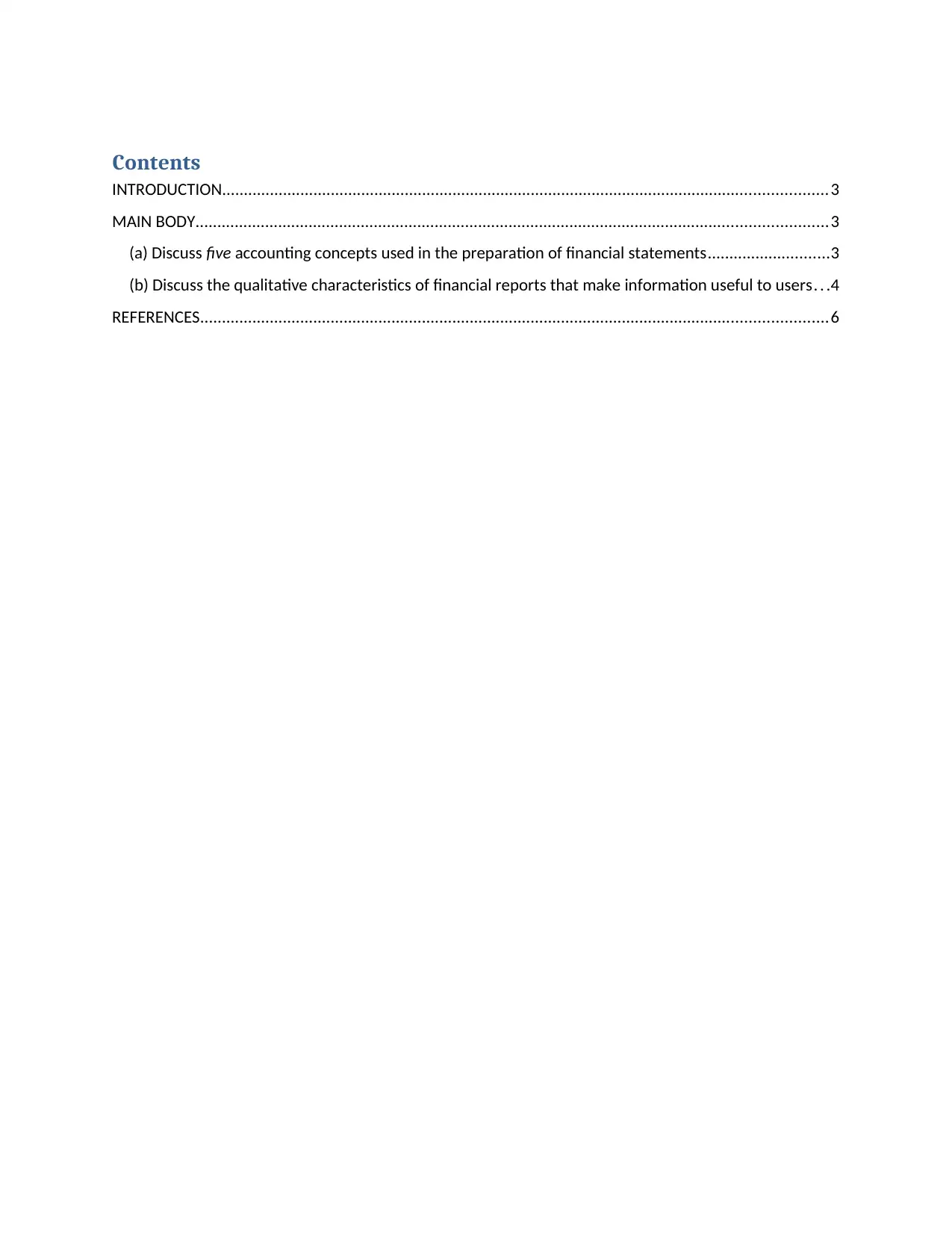
Contents
INTRODUCTION...........................................................................................................................................3
MAIN BODY.................................................................................................................................................3
(a) Discuss five accounting concepts used in the preparation of financial statements............................3
(b) Discuss the qualitative characteristics of financial reports that make information useful to users. . .4
REFERENCES................................................................................................................................................6
INTRODUCTION...........................................................................................................................................3
MAIN BODY.................................................................................................................................................3
(a) Discuss five accounting concepts used in the preparation of financial statements............................3
(b) Discuss the qualitative characteristics of financial reports that make information useful to users. . .4
REFERENCES................................................................................................................................................6
⊘ This is a preview!⊘
Do you want full access?
Subscribe today to unlock all pages.

Trusted by 1+ million students worldwide
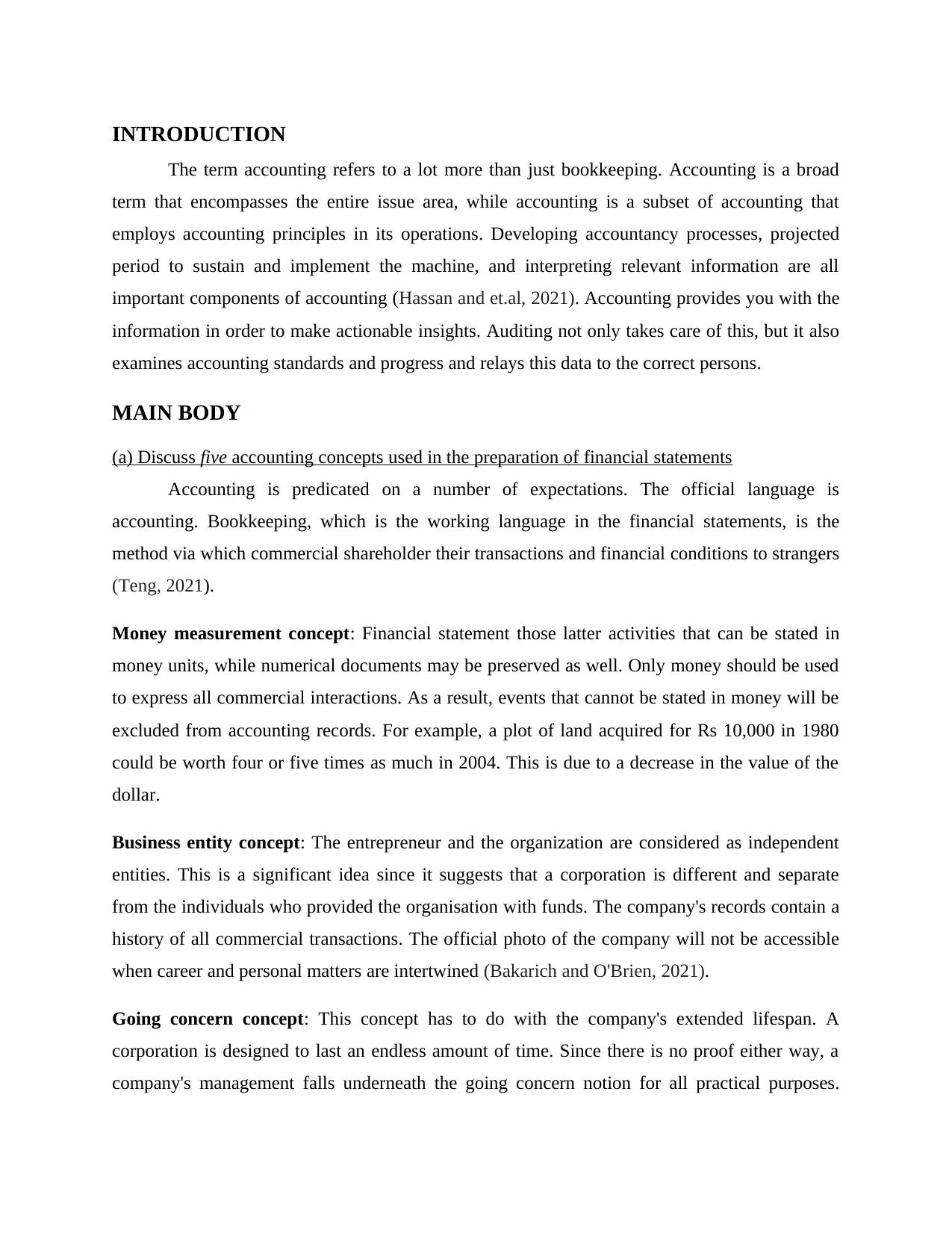
INTRODUCTION
The term accounting refers to a lot more than just bookkeeping. Accounting is a broad
term that encompasses the entire issue area, while accounting is a subset of accounting that
employs accounting principles in its operations. Developing accountancy processes, projected
period to sustain and implement the machine, and interpreting relevant information are all
important components of accounting (Hassan and et.al, 2021). Accounting provides you with the
information in order to make actionable insights. Auditing not only takes care of this, but it also
examines accounting standards and progress and relays this data to the correct persons.
MAIN BODY
(a) Discuss five accounting concepts used in the preparation of financial statements
Accounting is predicated on a number of expectations. The official language is
accounting. Bookkeeping, which is the working language in the financial statements, is the
method via which commercial shareholder their transactions and financial conditions to strangers
(Teng, 2021).
Money measurement concept: Financial statement those latter activities that can be stated in
money units, while numerical documents may be preserved as well. Only money should be used
to express all commercial interactions. As a result, events that cannot be stated in money will be
excluded from accounting records. For example, a plot of land acquired for Rs 10,000 in 1980
could be worth four or five times as much in 2004. This is due to a decrease in the value of the
dollar.
Business entity concept: The entrepreneur and the organization are considered as independent
entities. This is a significant idea since it suggests that a corporation is different and separate
from the individuals who provided the organisation with funds. The company's records contain a
history of all commercial transactions. The official photo of the company will not be accessible
when career and personal matters are intertwined (Bakarich and O'Brien, 2021).
Going concern concept: This concept has to do with the company's extended lifespan. A
corporation is designed to last an endless amount of time. Since there is no proof either way, a
company's management falls underneath the going concern notion for all practical purposes.
The term accounting refers to a lot more than just bookkeeping. Accounting is a broad
term that encompasses the entire issue area, while accounting is a subset of accounting that
employs accounting principles in its operations. Developing accountancy processes, projected
period to sustain and implement the machine, and interpreting relevant information are all
important components of accounting (Hassan and et.al, 2021). Accounting provides you with the
information in order to make actionable insights. Auditing not only takes care of this, but it also
examines accounting standards and progress and relays this data to the correct persons.
MAIN BODY
(a) Discuss five accounting concepts used in the preparation of financial statements
Accounting is predicated on a number of expectations. The official language is
accounting. Bookkeeping, which is the working language in the financial statements, is the
method via which commercial shareholder their transactions and financial conditions to strangers
(Teng, 2021).
Money measurement concept: Financial statement those latter activities that can be stated in
money units, while numerical documents may be preserved as well. Only money should be used
to express all commercial interactions. As a result, events that cannot be stated in money will be
excluded from accounting records. For example, a plot of land acquired for Rs 10,000 in 1980
could be worth four or five times as much in 2004. This is due to a decrease in the value of the
dollar.
Business entity concept: The entrepreneur and the organization are considered as independent
entities. This is a significant idea since it suggests that a corporation is different and separate
from the individuals who provided the organisation with funds. The company's records contain a
history of all commercial transactions. The official photo of the company will not be accessible
when career and personal matters are intertwined (Bakarich and O'Brien, 2021).
Going concern concept: This concept has to do with the company's extended lifespan. A
corporation is designed to last an endless amount of time. Since there is no proof either way, a
company's management falls underneath the going concern notion for all practical purposes.
Paraphrase This Document
Need a fresh take? Get an instant paraphrase of this document with our AI Paraphraser
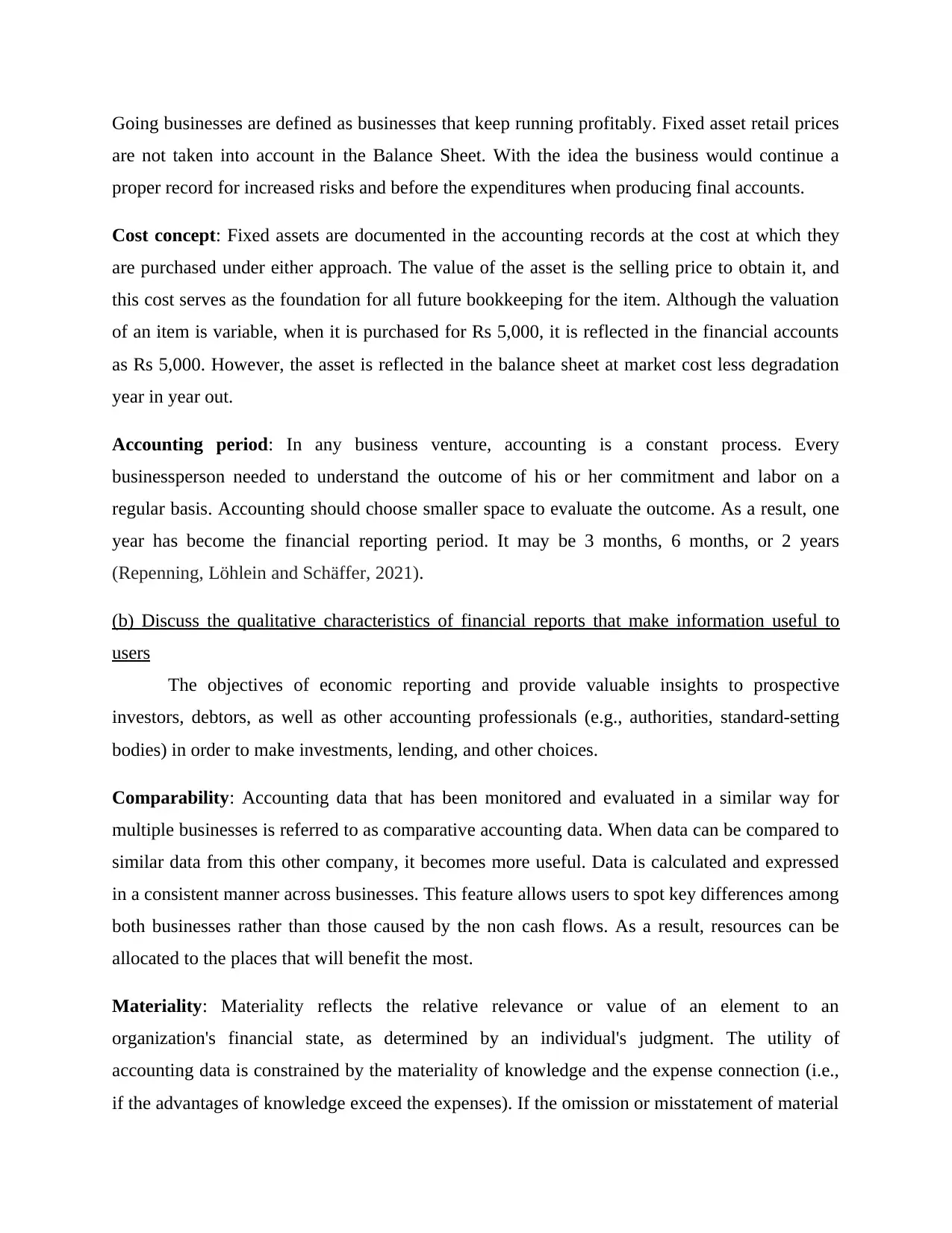
Going businesses are defined as businesses that keep running profitably. Fixed asset retail prices
are not taken into account in the Balance Sheet. With the idea the business would continue a
proper record for increased risks and before the expenditures when producing final accounts.
Cost concept: Fixed assets are documented in the accounting records at the cost at which they
are purchased under either approach. The value of the asset is the selling price to obtain it, and
this cost serves as the foundation for all future bookkeeping for the item. Although the valuation
of an item is variable, when it is purchased for Rs 5,000, it is reflected in the financial accounts
as Rs 5,000. However, the asset is reflected in the balance sheet at market cost less degradation
year in year out.
Accounting period: In any business venture, accounting is a constant process. Every
businessperson needed to understand the outcome of his or her commitment and labor on a
regular basis. Accounting should choose smaller space to evaluate the outcome. As a result, one
year has become the financial reporting period. It may be 3 months, 6 months, or 2 years
(Repenning, Löhlein and Schäffer, 2021).
(b) Discuss the qualitative characteristics of financial reports that make information useful to
users
The objectives of economic reporting and provide valuable insights to prospective
investors, debtors, as well as other accounting professionals (e.g., authorities, standard-setting
bodies) in order to make investments, lending, and other choices.
Comparability: Accounting data that has been monitored and evaluated in a similar way for
multiple businesses is referred to as comparative accounting data. When data can be compared to
similar data from this other company, it becomes more useful. Data is calculated and expressed
in a consistent manner across businesses. This feature allows users to spot key differences among
both businesses rather than those caused by the non cash flows. As a result, resources can be
allocated to the places that will benefit the most.
Materiality: Materiality reflects the relative relevance or value of an element to an
organization's financial state, as determined by an individual's judgment. The utility of
accounting data is constrained by the materiality of knowledge and the expense connection (i.e.,
if the advantages of knowledge exceed the expenses). If the omission or misstatement of material
are not taken into account in the Balance Sheet. With the idea the business would continue a
proper record for increased risks and before the expenditures when producing final accounts.
Cost concept: Fixed assets are documented in the accounting records at the cost at which they
are purchased under either approach. The value of the asset is the selling price to obtain it, and
this cost serves as the foundation for all future bookkeeping for the item. Although the valuation
of an item is variable, when it is purchased for Rs 5,000, it is reflected in the financial accounts
as Rs 5,000. However, the asset is reflected in the balance sheet at market cost less degradation
year in year out.
Accounting period: In any business venture, accounting is a constant process. Every
businessperson needed to understand the outcome of his or her commitment and labor on a
regular basis. Accounting should choose smaller space to evaluate the outcome. As a result, one
year has become the financial reporting period. It may be 3 months, 6 months, or 2 years
(Repenning, Löhlein and Schäffer, 2021).
(b) Discuss the qualitative characteristics of financial reports that make information useful to
users
The objectives of economic reporting and provide valuable insights to prospective
investors, debtors, as well as other accounting professionals (e.g., authorities, standard-setting
bodies) in order to make investments, lending, and other choices.
Comparability: Accounting data that has been monitored and evaluated in a similar way for
multiple businesses is referred to as comparative accounting data. When data can be compared to
similar data from this other company, it becomes more useful. Data is calculated and expressed
in a consistent manner across businesses. This feature allows users to spot key differences among
both businesses rather than those caused by the non cash flows. As a result, resources can be
allocated to the places that will benefit the most.
Materiality: Materiality reflects the relative relevance or value of an element to an
organization's financial state, as determined by an individual's judgment. The utility of
accounting data is constrained by the materiality of knowledge and the expense connection (i.e.,
if the advantages of knowledge exceed the expenses). If the omission or misstatement of material
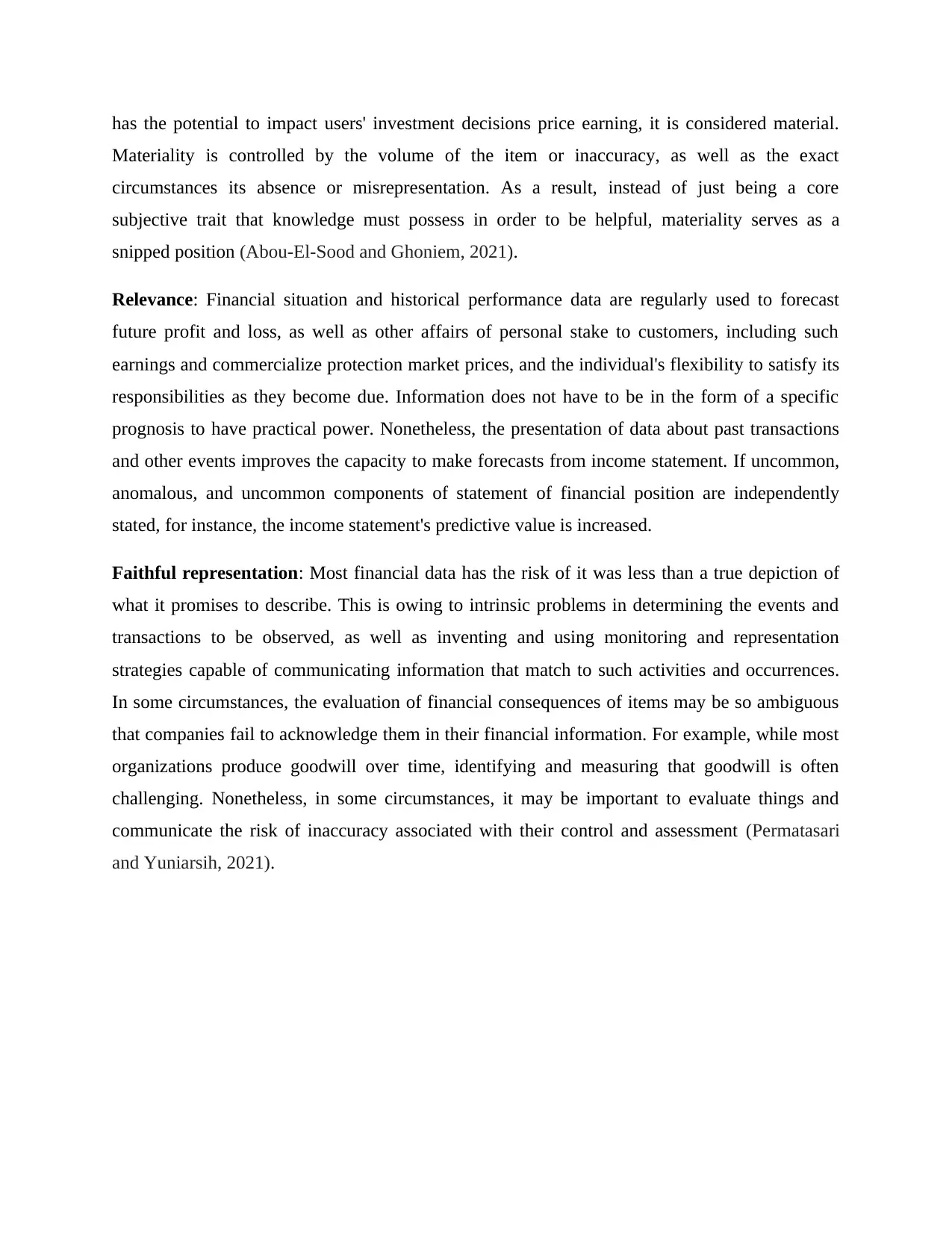
has the potential to impact users' investment decisions price earning, it is considered material.
Materiality is controlled by the volume of the item or inaccuracy, as well as the exact
circumstances its absence or misrepresentation. As a result, instead of just being a core
subjective trait that knowledge must possess in order to be helpful, materiality serves as a
snipped position (Abou-El-Sood and Ghoniem, 2021).
Relevance: Financial situation and historical performance data are regularly used to forecast
future profit and loss, as well as other affairs of personal stake to customers, including such
earnings and commercialize protection market prices, and the individual's flexibility to satisfy its
responsibilities as they become due. Information does not have to be in the form of a specific
prognosis to have practical power. Nonetheless, the presentation of data about past transactions
and other events improves the capacity to make forecasts from income statement. If uncommon,
anomalous, and uncommon components of statement of financial position are independently
stated, for instance, the income statement's predictive value is increased.
Faithful representation: Most financial data has the risk of it was less than a true depiction of
what it promises to describe. This is owing to intrinsic problems in determining the events and
transactions to be observed, as well as inventing and using monitoring and representation
strategies capable of communicating information that match to such activities and occurrences.
In some circumstances, the evaluation of financial consequences of items may be so ambiguous
that companies fail to acknowledge them in their financial information. For example, while most
organizations produce goodwill over time, identifying and measuring that goodwill is often
challenging. Nonetheless, in some circumstances, it may be important to evaluate things and
communicate the risk of inaccuracy associated with their control and assessment (Permatasari
and Yuniarsih, 2021).
Materiality is controlled by the volume of the item or inaccuracy, as well as the exact
circumstances its absence or misrepresentation. As a result, instead of just being a core
subjective trait that knowledge must possess in order to be helpful, materiality serves as a
snipped position (Abou-El-Sood and Ghoniem, 2021).
Relevance: Financial situation and historical performance data are regularly used to forecast
future profit and loss, as well as other affairs of personal stake to customers, including such
earnings and commercialize protection market prices, and the individual's flexibility to satisfy its
responsibilities as they become due. Information does not have to be in the form of a specific
prognosis to have practical power. Nonetheless, the presentation of data about past transactions
and other events improves the capacity to make forecasts from income statement. If uncommon,
anomalous, and uncommon components of statement of financial position are independently
stated, for instance, the income statement's predictive value is increased.
Faithful representation: Most financial data has the risk of it was less than a true depiction of
what it promises to describe. This is owing to intrinsic problems in determining the events and
transactions to be observed, as well as inventing and using monitoring and representation
strategies capable of communicating information that match to such activities and occurrences.
In some circumstances, the evaluation of financial consequences of items may be so ambiguous
that companies fail to acknowledge them in their financial information. For example, while most
organizations produce goodwill over time, identifying and measuring that goodwill is often
challenging. Nonetheless, in some circumstances, it may be important to evaluate things and
communicate the risk of inaccuracy associated with their control and assessment (Permatasari
and Yuniarsih, 2021).
⊘ This is a preview!⊘
Do you want full access?
Subscribe today to unlock all pages.

Trusted by 1+ million students worldwide
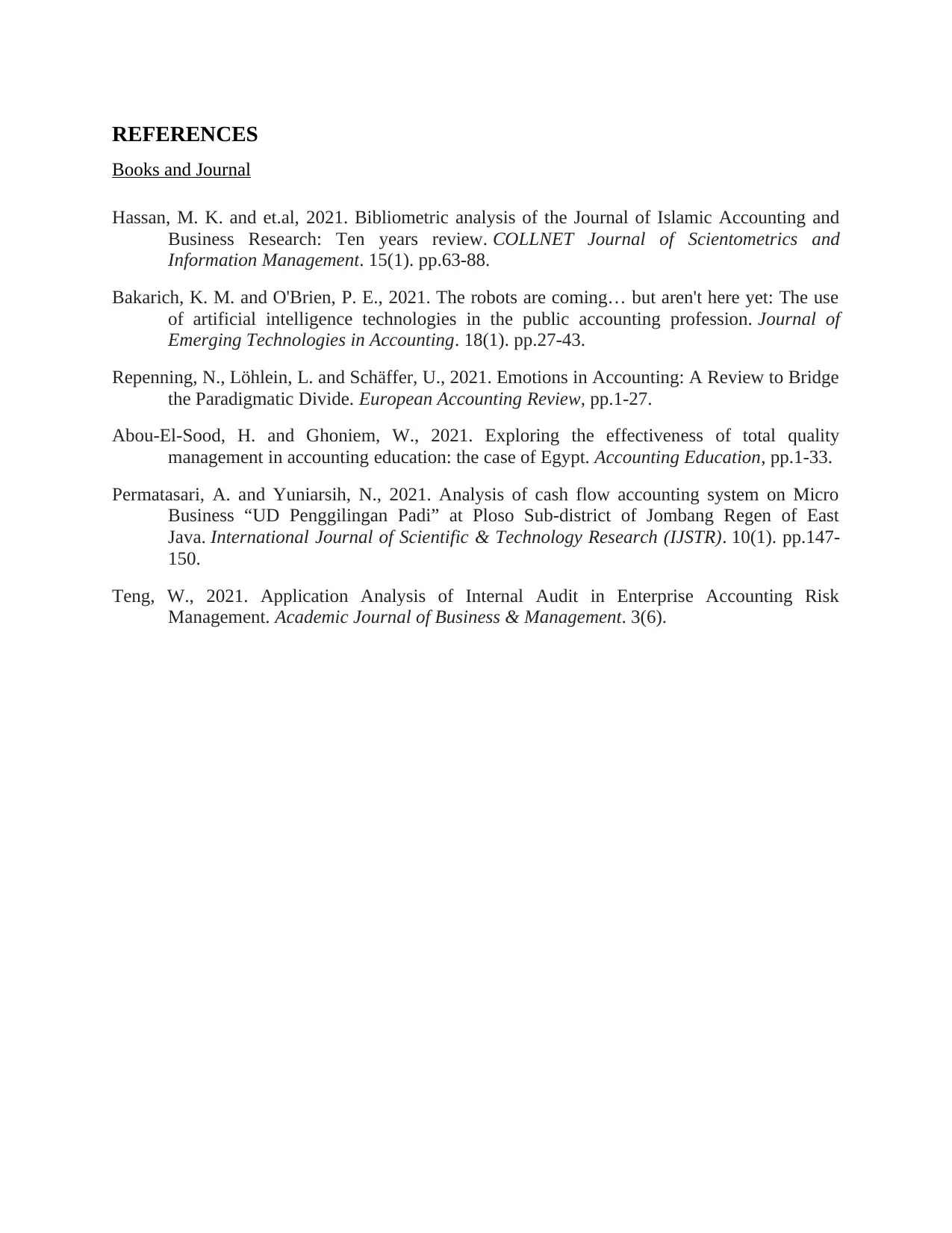
REFERENCES
Books and Journal
Hassan, M. K. and et.al, 2021. Bibliometric analysis of the Journal of Islamic Accounting and
Business Research: Ten years review. COLLNET Journal of Scientometrics and
Information Management. 15(1). pp.63-88.
Bakarich, K. M. and O'Brien, P. E., 2021. The robots are coming… but aren't here yet: The use
of artificial intelligence technologies in the public accounting profession. Journal of
Emerging Technologies in Accounting. 18(1). pp.27-43.
Repenning, N., Löhlein, L. and Schäffer, U., 2021. Emotions in Accounting: A Review to Bridge
the Paradigmatic Divide. European Accounting Review, pp.1-27.
Abou-El-Sood, H. and Ghoniem, W., 2021. Exploring the effectiveness of total quality
management in accounting education: the case of Egypt. Accounting Education, pp.1-33.
Permatasari, A. and Yuniarsih, N., 2021. Analysis of cash flow accounting system on Micro
Business “UD Penggilingan Padi” at Ploso Sub-district of Jombang Regen of East
Java. International Journal of Scientific & Technology Research (IJSTR). 10(1). pp.147-
150.
Teng, W., 2021. Application Analysis of Internal Audit in Enterprise Accounting Risk
Management. Academic Journal of Business & Management. 3(6).
Books and Journal
Hassan, M. K. and et.al, 2021. Bibliometric analysis of the Journal of Islamic Accounting and
Business Research: Ten years review. COLLNET Journal of Scientometrics and
Information Management. 15(1). pp.63-88.
Bakarich, K. M. and O'Brien, P. E., 2021. The robots are coming… but aren't here yet: The use
of artificial intelligence technologies in the public accounting profession. Journal of
Emerging Technologies in Accounting. 18(1). pp.27-43.
Repenning, N., Löhlein, L. and Schäffer, U., 2021. Emotions in Accounting: A Review to Bridge
the Paradigmatic Divide. European Accounting Review, pp.1-27.
Abou-El-Sood, H. and Ghoniem, W., 2021. Exploring the effectiveness of total quality
management in accounting education: the case of Egypt. Accounting Education, pp.1-33.
Permatasari, A. and Yuniarsih, N., 2021. Analysis of cash flow accounting system on Micro
Business “UD Penggilingan Padi” at Ploso Sub-district of Jombang Regen of East
Java. International Journal of Scientific & Technology Research (IJSTR). 10(1). pp.147-
150.
Teng, W., 2021. Application Analysis of Internal Audit in Enterprise Accounting Risk
Management. Academic Journal of Business & Management. 3(6).
1 out of 7
Related Documents
Your All-in-One AI-Powered Toolkit for Academic Success.
+13062052269
info@desklib.com
Available 24*7 on WhatsApp / Email
![[object Object]](/_next/static/media/star-bottom.7253800d.svg)
Unlock your academic potential
Copyright © 2020–2025 A2Z Services. All Rights Reserved. Developed and managed by ZUCOL.





